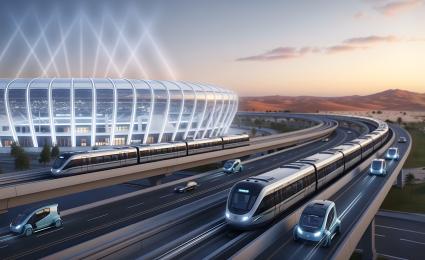Can Saudi Arabia build smart, sustainable transportation infrastructure in time for the FIFA World Cup 2034 – and ensure seamless mobility for all?


Transforming middle eastern mobility
High-impact measures beyond major infrastructure projects
Traffic congestion is a major challenge in the Middle East, particularly in GCC cities, where high car ownership, urban sprawl, and limited public transport accessibility place increasing pressure on road networks. While reported congestion levels for cities like Dubai (25%) and Riyadh (28%) appear moderate, actual traffic conditions are more severe due to high vehicle concentration on major roads and highways.

In Dubai, congestion is heavily concentrated on Sheikh Zayed Road and other key corridors, where peak-hour traffic can significantly extend commute times. Private car ownership remains at a high level compared to other main GCC cities at 622 vehicles per 1,000 people, reinforcing dependence on road networks despite the availability of metro, bus, and tram services. As a result, commuters lose 46 hours annually to rush-hour congestion, particularly in business and residential hubs. Similarly, in Riyadh, 58 hours per year are lost in congestion, with travel times extending by up to 86% during peak hours.
As urban populations grow and commuting demand increases, addressing congestion will require a more balanced approach to urban mobility—one that expands public transport, improves last-mile connectivity, and creates more seamless alternatives to private car use.
Building the ideal mobility ecosystem: A long-term vision vs the reality
So, what can cities in the Middle East do to ease congestion and create a more efficient mobility ecosystem?
The vision for mobility development and integration is clear—reducing reliance on private cars and creating a well-connected, sustainable transport network. The foundation of this shift lies in major infrastructure investments, ensuring that high-capacity public transport options are available to support growing urban populations.
"Effective mobility ecosystems aren’t built on infrastructure alone — they thrive on seamless integration between modes, smart digital solutions, and a strong focus on user experience"
In an ideal world, unlimited funding could transform urban mobility. Dense networks of metro lines, tramways, Bus Rapid Transit (BRT) systems, Transit-Oriented Developments (TODs) , and extensive shaded and climatized Park-and-Ride facilities could dramatically reshape how cities move. Direct transit connections into key points of interest, such as mall basements, business hubs, and well-attended hotels, would further enhance usability and reduce reliance on private vehicles.
However, reality imposes significant limitations. Public transport megaprojects like metro networks are among the most capital-intensive infrastructure endeavors. For example, Riyadh's 176-kilometer metro project, spanning six lines and 85 stations, has required several years and billions of dollars to bring into operation. Similarly, Dubai's ongoing metro and tram expansions come at sizable financial cost, with the 30-kilometer Blue Line projected at USD 5.6 billion.
While large-scale infrastructure projects remain essential for long-term transformation, they are not the only path to improving urban mobility.
Middle Eastern cities can also make significant progress by focusing on practical, targeted measures that enhance accessibility and reduce congestion in the near term. These efforts should not be seen as a replacement for major investments, but as a way to complement them -delivering visible results while longer-term projects take shape. Experience shows that when public transport becomes more convenient and connected, people are willing to shift their travel habits. This is already becoming evident not only among expatriates in cities like Dubai but also among local populations. For example, Riyadh’s newly launched metro system recorded over 40 million passengers by mid-April, a strong indication of growing public readiness to embrace high-quality transit options. While such large projects take years to implement, they underscore the opportunity: if convenient and efficient options are available, people will use them. Smaller-scale interventions can build on this momentum by making the entire journey, from doorstep to destination, more seamless.
"GCC cities are clearly shifting their approach to mobility system development—from CAPEX-heavy mass transit projects to more flexible solutions such as shuttles and on-demand transport. These alternatives enable better integration, expand mobility catchment areas, and make transportation more accessible and user-friendly for thousands of people"
Quick Wins: Increasing Public Transport Adoption Without Heavy CAPEX
To accelerate this shift in travel behavior and maximize the value of ongoing investments, cities should pursue a set of focused, cost-effective measures that can be implemented quickly. These interventions don’t require major capital outlays but can significantly improve the overall functionality and attractiveness of the transport network—making public transit more accessible, connected, and competitive with private car use.
"Last Mile" Transit Solutions
Introducing feeder buses, micro buses, or shuttle services from residential areas and key business hubs (e.g., Dubai DIFC and Riyadh KAFD) to major public transportation nodes, such as metro stations, is crucial for enhancing "last mile" connectivity and making public transit more accessible. The introduction of feeder bus services in Dubai represents a step toward better integration of communities into the public transport network. While current coverage focuses on selected residential areas, there is room to enhance aspects such as vehicle availability, service frequency, and digital platform functionality. With continued improvements in planning and operations, these services can offer a viable complement to private vehicles and help alleviate urban traffic pressures.
Direct Airport Transit to Hotels and Core Business Hubs
This approach is crucial in major tourist and business centers in GCC cities, which regularly see high numbers of international travelers moving from airports to popular hotels and business hubs. Implementing such services can reduce congestion in city centers and enhance the overall travel experience, thereby boosting the city's appeal to business professionals and international visitors.
Airports like Los Angeles International Airport (LAX) and Singapore's Changi Airport provide integrated shuttle services that directly connect travelers to key hotels and business districts, effectively reducing reliance on private vehicles and easing congestion. These well-coordinated services help streamline the travel experience, ensuring smoother and more efficient urban mobility.
Digitalized Park-and-Ride
Park-and-ride can reduce urban traffic by encouraging commuters to park on the outskirts of the city and complete their journey using public transport. This solution helps manage traffic congestion, especially for long-distance commuters, by limiting the number of private vehicles entering city centers.
In the GCC, cities like Riyadh and Abu Dhabi have begun rolling out such solutions. In Riyadh, a number of park-and-ride facilities have been introduced alongside the metro and bus systems to support multimodal travel near key stations. Abu Dhabi’s system reflects this regional shift through a digitally integrated park-and-ride service, with parking facilities connected to shuttle routes serving major business and event districts. Supported by a mobile app that provides real-time parking availability, bus schedules, and route planning, it marks as a step toward integration-driven vision of urban mobility.
To further enhance this service, additional digital features could be introduced. These could include predictive parking availability, integrated payment systems, preference-based route suggestions, and ride-hailing integration for last-mile connectivity. Such improvements would make park-and-ride services more seamless and efficient, hence encouraging wider use and further reducing urban traffic congestion.
Enabling the role of ride-hailing platforms
Ride-hailing platforms have the potential to reduce traffic congestion in GCC cities, especially when integrated as a last-mile solution connecting commuters to metro and rail stations. By providing a convenient alternative to private cars, ride-hailing can help reduce the need for parking in high-density areas like KAFD in Riyadh, where parking search traffic contributes to congestion.
To support the broader integration of ride-hailing into urban mobility networks, regulatory refinements can play a role—such as enabling more collaboration between licensed taxis and platform operators, encouraging service coverage near public transport nodes, and supporting shared-ride options. These adjustments can help make ride-hailing more accessible, better utilized, and more aligned with public transport goals.
Collaborative Actions as One Ecosystem
The transformation of passenger mobility in the Middle East requires cooperation among all stakeholders, where everyone needs to play a key role in delivering quick wins:
- Public sector stakeholders can explore partnerships with ride-hailing platforms, where key destinations—such as business hubs, malls, or event venues—offer incentives to drivers, particularly those enabling ride-sharing and serving high-demand areas. This approach can improve service availability at critical nodes and support integration by encouraging shared, efficient use of vehicles during peak demand.
- Urban planners can prioritize last-mile transit solutions during urban design, such as feeder buses connecting residential areas to metro stations, and strategically locate park-and-ride facilities. This ensures smooth transitions from private to public transportation, addressing infrastructure accessibility by creating an extensive, dense network through well-connected physical networks that allow for easy movement between modes of transport.
- Transportation operators play a key role in expanding direct transit services to major locations such as hotels and business hubs. By integrating these services with public transport and e-hailing platforms, operators can reduce congestion while improving the overall network. This supports the integration of mobility operations by allowing for adaptable and optimized transportation systems.
- Digital mobility service providers, such as e-hailing platforms, can significantly impact the system by improving ride-sharing functionality and integrating with last-mile solutions and park-and-ride facilities. They can further enhance their services by embedding real-time data sharing and intelligent routing.
In conclusion, by working together, each stakeholder can contribute to reducing congestion and developing a more efficient and accessible transportation network. The time is ripe for collaborative action, and every player's involvement is essential.
How can Roland Berger help?
Roland Berger supports cities and mobility stakeholders in designing high-impact, cost-effective solutions that go beyond infrastructure megaprojects . We help clients identify and prioritize scalable interventions, such as last-mile connectivity, park-and-ride systems, and ride-hailing integration, that improve accessibility and reduce congestion. By combining strategic planning, regulatory insights, and data-driven modeling, we enable public and private actors to collaborate effectively and unlock the full potential of existing networks. Our goal is to accelerate tangible mobility improvements that enhance urban efficiency, sustainability, and user experience.
We would like to especially thank Wesley Han for his exceptional contribution in writing this report.







